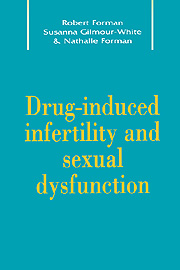6 - Antibiotics
Published online by Cambridge University Press: 30 March 2010
Summary
Sulphonamides
Sulphasalazine
Sulphasalazine has been used in the treatment of inflammatory bowel disease since 1942, although the first reports of sperm toxicity only appeared in 1979. Sulphasalazine is taken orally and reaches the colon intact. As a result of the action of colonic bacteria, the compound is split into its constituents sulphapyridine and 5-aminosalicylic acid. It is useful to follow the sulphasalazine story in some detail. It is one of the few drugs for which clinical observation of reproductive side effects has led to detailed study of the underlying mechanisms responsible for the side effects. This has resulted in identification of the toxic component and a change in the pharmacological formulation.
Two separate reports in 1979 drew attention to men with inflammatory bowel disease presenting with infertility while being treated with long-term sulphasalazine. Levi et al (1979) noted reduced sperm count and motility that improved after withdrawal of the drug. Three of the four men fathered children when sulphasalazine was discontinued. The sperm abnormalities returned when the drug was reintroduced. Toth described 10 subfertile men on sulphasalazine. Six stopped treatment and their wives all conceived. He also noted a particular sperm morphological abnormality consisting of a ballooned enlarged sperm with a pale staining head. This appearance was thought to result from immaturity of the sperm coupled with osmotic damage to the membrane structures (Toth, 1979a,b). Others also described large numbers of immature sperm, suggesting a toxic action on sperm maturation. At this time, it was also postulated that the adverse effect could be related to the antiprostaglandin action of sulphasalazine, as prostaglandins are thought to be implicated in sperm motility (Traub, Thompson & Carville, 1979).
- Type
- Chapter
- Information
- Drug-Induced Infertility and Sexual Dysfunction , pp. 85 - 91Publisher: Cambridge University PressPrint publication year: 1996
- 1
- Cited by



